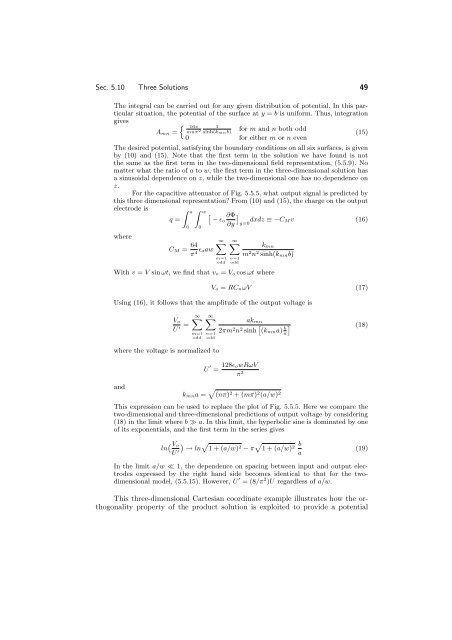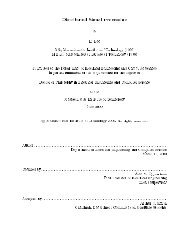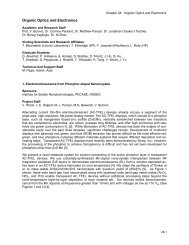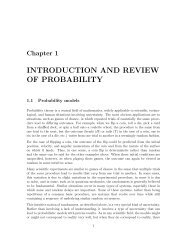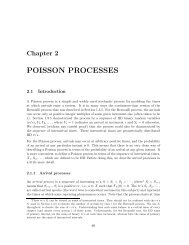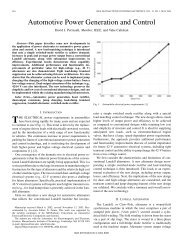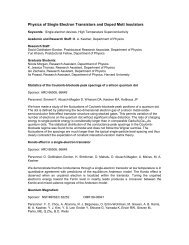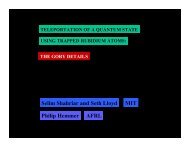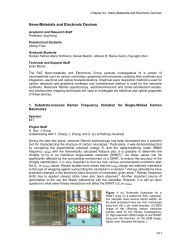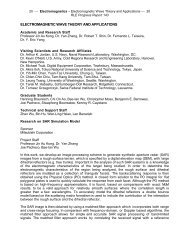Electromagnetic Fields and Energy - Chapter 5 ... - MIT
Electromagnetic Fields and Energy - Chapter 5 ... - MIT
Electromagnetic Fields and Energy - Chapter 5 ... - MIT
Create successful ePaper yourself
Turn your PDF publications into a flip-book with our unique Google optimized e-Paper software.
Sec. 5.10 Three Solutions 49<br />
The integral can be carried out for any given distribution of potential. In this particular<br />
situation, the potential of the surface at y = b is uniform. Thus, integration<br />
gives<br />
<br />
16v 1<br />
A<br />
for m <strong>and</strong> n both odd<br />
mn = mnπ 2 sinh(k mn b) (15)<br />
0 for either m or n even<br />
The desired potential, satisfying the boundary conditions on all six surfaces, is given<br />
by (10) <strong>and</strong> (15). Note that the first term in the solution we have found is not<br />
the same as the first term in the twodimensional field representation, (5.5.9). No<br />
matter what the ratio of a to w, the first term in the threedimensional solution has<br />
a sinusoidal dependence on z, while the twodimensional one has no dependence on<br />
z.<br />
For the capacitive attenuator of Fig. 5.5.5, what output signal is predicted by<br />
this three dimensional representation? From (10) <strong>and</strong> (15), the charge on the output<br />
electrode is<br />
where<br />
a<br />
w ∂Φ<br />
q = − o<br />
0 0<br />
dxdz ≡ −C M v (16)<br />
∂y y=0<br />
∞ ∞<br />
64 <br />
C M = oaw<br />
k mn<br />
π 4<br />
m 2 n 2 sinh(k mnb)<br />
m=1 n=1<br />
odd odd<br />
With v = V sin ωt, we find that v o = V o cos ωt where<br />
V o = RC nωV (17)<br />
Using (16), it follows that the amplitude of the output voltage is<br />
∞ ∞<br />
V o<br />
ak mn<br />
=<br />
<br />
U 2πm 2 n 2 b<br />
sinh<br />
m=1 n=1 (kmn a) a<br />
odd odd<br />
(18)<br />
where the voltage is normalized to<br />
<strong>and</strong><br />
U =<br />
128 o wRωV<br />
π 3<br />
k mna =<br />
<br />
(nπ)<br />
2<br />
+ (mπ) 2 (a/w) 2<br />
This expression can be used to replace the plot of Fig. 5.5.5. Here we compare the<br />
twodimensional <strong>and</strong> threedimensional predictions of output voltage by considering<br />
(18) in the limit where b a. In this limit, the hyperbolic sine is dominated by one<br />
of its exponentials, <strong>and</strong> the first term in the series gives<br />
b<br />
ln V o<br />
→ ln 1 + (a/w)<br />
U 2 − π 1 + (a/w) 2 (19)<br />
a<br />
In the limit a/w 1, the dependence on spacing between input <strong>and</strong> output electrodes<br />
expressed by the right h<strong>and</strong> side becomes identical to that for the twodimensional<br />
model, (5.5.15). However, U = (8/π 2 )U regardless of a/w.<br />
This threedimensional Cartesian coordinate example illustrates how the orthogonality<br />
property of the product solution is exploited to provide a potential


